非谓语动词形式讲解附解析百度文库
- 格式:doc
- 大小:119.50 KB
- 文档页数:12
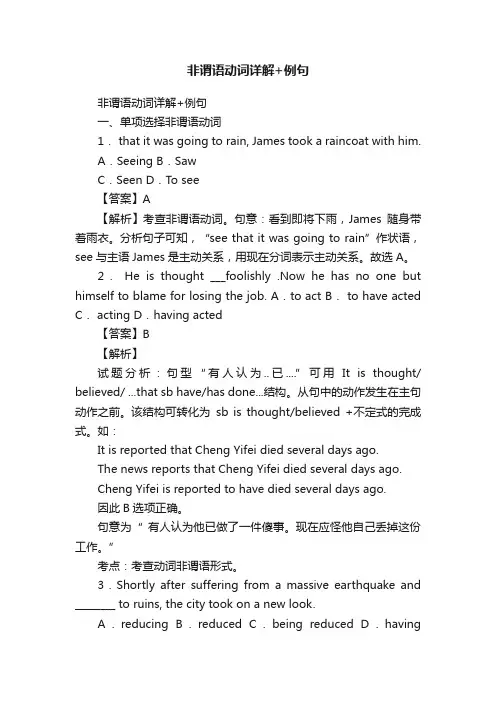
非谓语动词详解+例句非谓语动词详解+例句一、单项选择非谓语动词1. that it was going to rain, James took a raincoat with him.A.Seeing B.SawC.Seen D.To see【答案】A【解析】考查非谓语动词。
句意:看到即将下雨,James随身带着雨衣。
分析句子可知,“see that it was going to rain”作状语,see与主语James是主动关系,用现在分词表示主动关系。
故选A。
2.He is thought ___foolishly .Now he has no one but himself to blame for losing the job. A.to act B. to have acted C. acting D.having acted【答案】B【解析】试题分析:句型“有人认为..已....”可用It is thought/ believed/ ...that sb have/has done...结构。
从句中的动作发生在主句动作之前。
该结构可转化为sb is thought/believed +不定式的完成式。
如:It is reported that Cheng Yifei died several days ago.The news reports that Cheng Yifei died several days ago.Cheng Yifei is reported to have died several days ago.因此B选项正确。
句意为“ 有人认为他已做了一件傻事。
现在应怪他自己丢掉这份工作。
”考点:考查动词非谓语形式。
3.Shortly after suffering from a massive earthquake and ________ to ruins, the city took on a new look.A.reducing B.reduced C.being reduced D.havingreduced 【答案】C【解析】【详解】考查动名词的被动语态。
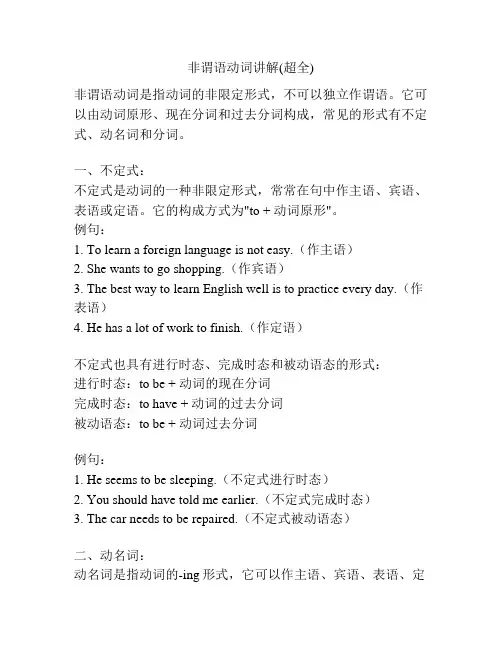
非谓语动词讲解(超全)非谓语动词是指动词的非限定形式,不可以独立作谓语。
它可以由动词原形、现在分词和过去分词构成,常见的形式有不定式、动名词和分词。
一、不定式:不定式是动词的一种非限定形式,常常在句中作主语、宾语、表语或定语。
它的构成方式为"to + 动词原形"。
例句:1. To learn a foreign language is not easy.(作主语)2. She wants to go shopping.(作宾语)3. The best way to learn English well is to practice every day.(作表语)4. He has a lot of work to finish.(作定语)不定式也具有进行时态、完成时态和被动语态的形式:进行时态:to be + 动词的现在分词完成时态:to have + 动词的过去分词被动语态:to be + 动词过去分词例句:1. He seems to be sleeping.(不定式进行时态)2. You should have told me earlier.(不定式完成时态)3. The car needs to be repaired.(不定式被动语态)二、动名词:动名词是指动词的-ing形式,它可以作主语、宾语、表语、定语或状语。
在句中的位置和用法与名词相似。
例句:1. Reading is my favorite hobby.(作主语)2. I enjoy swimming in the summer.(作宾语)3. Her dream is becoming a famous singer.(作表语)4. The girl standing over there is my sister.(作定语)5. He went to the party without saying goodbye.(作状语)动名词与不定式的区别在于动名词具有进行时态和被动语态,而不定式没有。

非谓语动词讲解归纳非谓语动词是指在句子中充当谓语的动词形式,不具备人称和数的变化,也不与主语保持一致。
常见的非谓语动词有动词不定式、动名词和分词。
下面我将对这三种非谓语动词进行讲解和归纳。
1. 动词不定式:动词不定式是动词的一种非谓语形式,一般由“to + 动词原形”构成,例如:"to read","to eat"。
动词不定式的用法:a. 作主语:To travel is my dream.(旅行是我的梦想)b. 作宾语:I want to eat an apple.(我想吃一个苹果)c. 作补语:Her dream is to become a doctor.(她的梦想是成为一名医生)d. 作定语:We need someone to help us.(我们需要有人帮助我们)2. 动名词:动名词是将动词变为名词的一种形式,一般以-ing结尾,例如:"reading","writing"。
动名词的用法:a. 作主语:Reading is my hobby.(读书是我的爱好)b. 作宾语:I enjoy swimming in the summer.(我喜欢夏天游泳)c. 作定语:I have a writing notebook.(我有一个写作笔记本)d. 作表语:Her favorite activity is dancing.(她最喜欢的活动是跳舞)3. 分词:分词是动词的一种非谓语形式,一般以-ing或-ed结尾,分别称为现在分词和过去分词,例如:"running","cooked"。
分词的用法:a. 现在分词作定语:The running water is very clean.(流动的水很干净)b. 过去分词作定语:The cooked chicken smells delicious.(煮熟的鸡肉闻起来很香)c. 分词作伴随状语:Hearing the news, she smiled happily.(听到消息,她高兴地笑了)需要注意的是,非谓语动词的形式可以有时态和语态的变化,如不定式可以有完成和进行的形式,动名词可以有进行和完成的形式,分词可以有进行、完成和被动的形式。
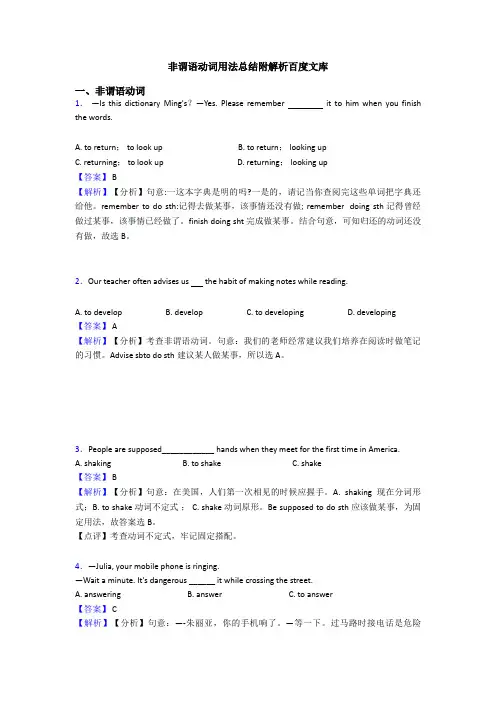
非谓语动词用法总结附解析百度文库一、非谓语动词1.—Is this dictionary Ming's?—Yes. Please remember it to him when you finish the words.A. to return; to look upB. to return; looking upC. returning; to look upD. returning; looking up【答案】 B【解析】【分析】句意:一这本字典是明的吗?一是的,请记当你查阅完这些单词把字典还给他。
remember to do sth:记得去做某事,该事情还没有做; remember doing sth记得曾经做过某事,该事情已经做了。
finish doing sht完成做某事。
结合句意,可知归还的动词还没有做,故选B。
2.Our teacher often advises us the habit of making notes while reading.A. to developB. developC. to developingD. developing【答案】 A【解析】【分析】考查非谓语动词。
句意:我们的老师经常建议我们培养在阅读时做笔记的习惯。
Advise sbto do sth建议某人做某事,所以选A。
3.People are supposed____________ hands when they meet for the first time in America.A. shakingB. to shakeC. shake【答案】 B【解析】【分析】句意:在美国,人们第一次相见的时候应握手。
A. shaking现在分词形式;B. to shake动词不定式; C. shake动词原形。
Be supposed to do sth应该做某事,为固定用法,故答案选B。

高考英语语法非谓语动词解析一. 非谓语动词的含义非谓语动词首先是一种动词形式,其次是这种动词形式不能做谓语,综合这两点,我们将其叫做非谓语动词。
二. 非谓语动词的形式非谓语动词包含四种形式,即不定式、动名词、现在分词和过去分词。
其中,每种形式按照发生时间和主被动又包括不同的子形式。
具体如下:1. 不定式①基本形式:to do(表示主动,并且一般表示将来)②被动式:to be done(表示被动,并且一般表示将来)③进行式:to be doing (表示主动和进行)④完成时:to have done(表示主动和完成)⑤完成被动式:to have been done(表示被动和完成)⑥完成进行式:to have been doing (表示主动和完成进行)例如:The teacher told us to do morning exercises .老师让我们做早操。
The car to be bought is for his sister.要买的这辆车是给他的姐姐的。
She pretended to be reading when the teacher came into the classroom.老师进来时,她假装正在读书。
The thief is said to have escaped.据说小偷已经逃跑了。
The thief is said to have been arrested.据说小偷已经被抓住了。
She is said to have been working in the factory over the last 20 years.据说在过去的20年里,她一直在这家工厂工作。
2. 动名词①基本形式:doing (表示主动)②被动式:being done(表示被动)③完成式:having done(表示主动和完成)④完成被动式:having been done(表示被动和完成)例如:Travelling in space by ordinary people will be common in the future.在未来,普通人在太空旅行将会是普遍的事情。
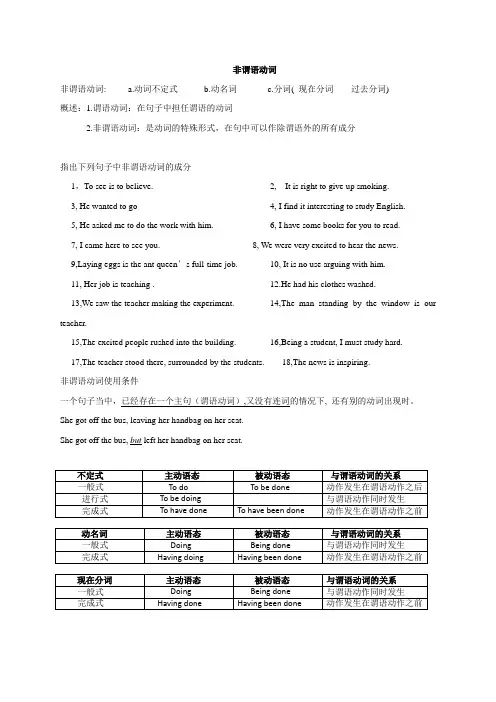
非谓语动词非谓语动词: a.动词不定式 b.动名词 c.分词( 现在分词过去分词)概述:1.谓语动词:在句子中担任谓语的动词2.非谓语动词:是动词的特殊形式,在句中可以作除谓语外的所有成分指出下列句子中非谓语动词的成分1,To see is to believe. 2, It is right to give up smoking.3, He wanted to go 4, I find it interesting to study English.5, He asked me to do the work with him. 6, I have some books for you to read.7, I came here to see you. 8, We were very excited to hear the news.9,Laying eggs is the ant queen’s full-time job. 10, It is no use arguing with him.11, Her job is teaching . 12.He had his clothes washed.13,We saw the teacher making the experiment. 14,The man standing by the window is our teacher.15,The excited people rushed into the building. 16,Being a student, I must study hard.17,The teacher stood there, surrounded by the students. 18,The news is inspiring.非谓语动词使用条件一个句子当中,已经存在一个主句(谓语动词),又没有连词的情况下, 还有别的动词出现时。
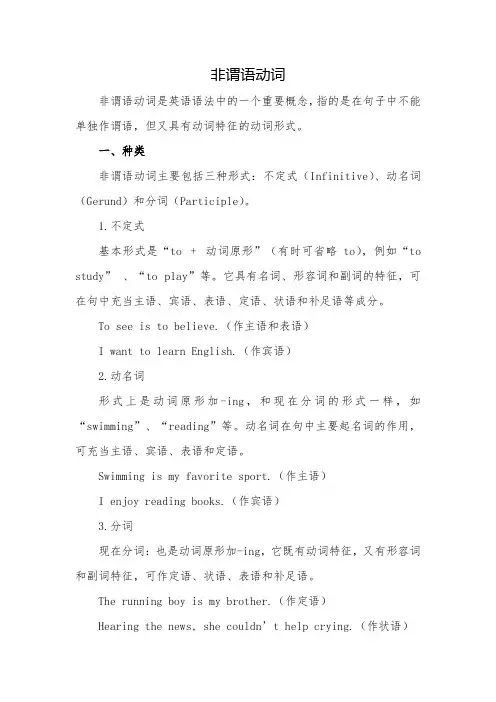
非谓语动词非谓语动词是英语语法中的一个重要概念,指的是在句子中不能单独作谓语,但又具有动词特征的动词形式。
一、种类非谓语动词主要包括三种形式:不定式(Infinitive)、动名词(Gerund)和分词(Participle)。
1.不定式基本形式是“to + 动词原形”(有时可省略to),例如“to study”、“to play”等。
它具有名词、形容词和副词的特征,可在句中充当主语、宾语、表语、定语、状语和补足语等成分。
To see is to believe.(作主语和表语)I want to learn English.(作宾语)2.动名词形式上是动词原形加-ing,和现在分词的形式一样,如“swimming”、“reading”等。
动名词在句中主要起名词的作用,可充当主语、宾语、表语和定语。
Swimming is my favorite sport.(作主语)I enjoy reading books.(作宾语)3.分词现在分词:也是动词原形加-ing,它既有动词特征,又有形容词和副词特征,可作定语、状语、表语和补足语。
The running boy is my brother.(作定语)Hearing the news, she couldn’t help crying.(作状语)过去分词:通常是动词原形加-ed(规则变化)或有其特殊的不规则变化形式,如“broken”、“written”等。
过去分词常表示被动或完成的意义,同样能充当定语、状语、表语和补足语等成分。
The broken cup is on the table.(作定语)Given more time, I can do it better.(作状语)二、用法区别1.作主语时不定式作主语常表示具体的某一次动作或行为,常用“It + be + 形容词+ (for/of sb.) + to do sth.”这样的结构,It is important for us to learn English well.动名词作主语往往表示抽象的、一般性的行为或概念。

非谓语动词详解+例句一、单项选择非谓语动词1.New York is the fashion capital of the world, says a new study on Feb 4. 2014 by the Global Language Monitor (GLM), Pairs second, with Shanghai 10th while Hongkong 20th.A. coming, ranksB. come, rankedC. comes, rankingD. coming, ranking【答案】D【解析】D考查非谓语动词。
句意:2月4 口的一项新研究表明,纽约是世界的时尚之都。
2014年全球语言监测机构(GLM)排名第二,上海排名第10,香港排名第20。
Come和Pair是主动关系用动词ing形式,rank与Shanghai是主动关系,用动词ing形式,故选D。
2.I'm afraid that I can't attend Tom's wedding party next weekend.A. to be heldB. being heldC. heldD. is to be held【答案】A【解析】试题分析:考查非谓语动词作定语。
句子中已经有了谓语can't attend,故此处应填非谓语动词,首先排除D。
hold与party构成被动关系,但ABC答案均表被动。
因此再根据时间状语next weekend可确定填不定式表将来,故选A。
考查非谓语动词作定语时,要注意看与所修饰名词之间的关系,判断是主动还是被动。
同时还要注意从时间上判定,不定式作定语表将来,现在分词表进行,过去分词表完成。
考点:考查非谓语动词作定语。
3.that she was going off to sleep, I asked if she/d like that little doll on her bed.A. SeeingB. To seeC. SeeD. Seen【答案】A【解析】考查非谓语动词的用法。

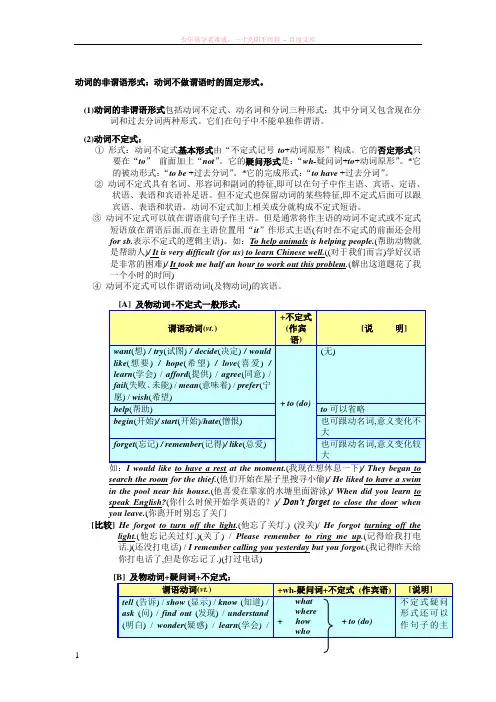
动词的非谓语形式:动词不做谓语时的固定形式。
(1)动词的非谓语形式包括动词不定式、动名词和分词三种形式;其中分词又包含现在分词和过去分词两种形式。
它们在句子中不能单独作谓语。
(2)动词不定式:①形式:动词不定式基本形式由“不定式记号to+动词原形”构成。
它的否定形式只要在“to”前面加上“not”。
它的疑问形式是:“wh-疑问词+to+动词原形”。
*它的被动形式:“to be +过去分词”。
*它的完成形式:“to have +过去分词”。
②动词不定式具有名词、形容词和副词的特征,即可以在句子中作主语、宾语、定语、状语、表语和宾语补足语。
但不定式也保留动词的某些特征,即不定式后面可以跟宾语、表语和状语。
动词不定式加上相关成分就构成不定式短语。
③动词不定式可以放在谓语前句子作主语。
但是通常将作主语的动词不定式或不定式短语放在谓语后面,而在主语位置用“it”作形式主语(有时在不定式的前面还会用for sb.表示不定式的逻辑主语)。
如:To help animals is helping people.(帮助动物就是帮助人)/ It is very difficult (for us) to learn Chinese well.((对于我们而言)学好汉语是非常的困难)/ It took me half an hour to work out this problem.(解出这道题花了我一个小时的时间)④动词不定式可以作谓语动词(及物动词)的宾语。
[A] 及物动词+不定式一般形式:谓语动词(vt.) +不定式(作宾语)[说明]want(想) / try(试图) / decide(决定) / wouldlike(想要) / hope(希望) / love(喜爱) /learn(学会) / afford(提供) / agree(同意) /fail(失败、未能) / mean(意味着) / prefer(宁愿) / wish(希望)+ to (do)(无)help(帮助) to可以省略begin(开始)/ start(开始)/hate(憎恨)也可跟动名词,意义变化不大forget(忘记) / remember(记得)/ like(总爱)也可跟动名词,意义变化较大to have a rest began to search the room for the thief.(他们开始在屋子里搜寻小偷)/ He liked to have a swim in the pool near his house.(他喜爱在靠家的水塘里面游泳)/ When did you learn to speak English?(你什么时候开始学英语的?)/ Don’t forget to close the door when you leave.(你离开时别忘了关门[比较] He forgot to turn off the light.(他忘了关灯.) (没关)/ He forgot turning off the light.(他忘记关过灯.)(关了) /Please remember to ring me up.(记得给我打电话.)(还没打电话) / I remember calling you yesterday but you forgot.(我记得昨天给你打电话了,但是你忘记了.)(打过电话)[B] 及物动词+疑问词+不定式:谓语动词(vt.) +wh-疑问词+不定式(作宾语) [说明]tell (告诉) / show (显示) / know (知道) / ask (问) / find out (发现) / understand (明白) / wonder(疑惑) / learn(学会) /whatwhere+ how + to (do)who不定式疑问形式还可以作句子的主forget(忘记) / remember(记得) / teach sb.(教某人) / discuss(商讨) which……语、表语等。
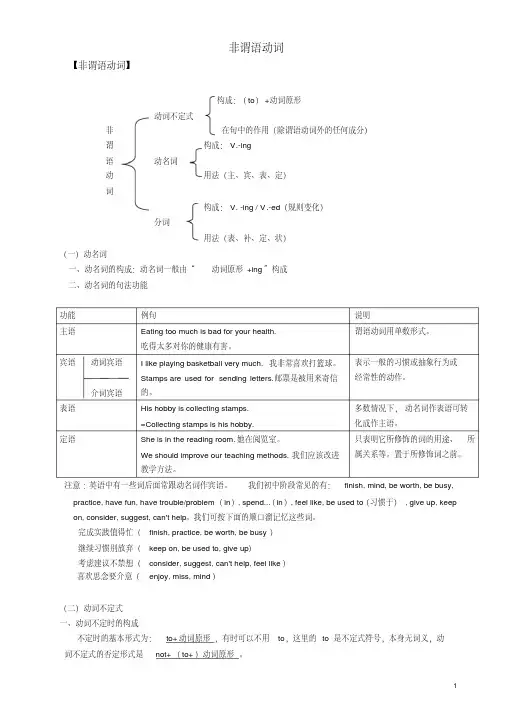
非谓语动词【非谓语动词】构成:(to)+动词原形动词不定式非在句中的作用(除谓语动词外的任何成分)谓构成:V.-ing语动名词动用法(主、宾、表、定)词构成:V. -ing / V.-ed(规则变化)分词用法(表、补、定、状)(一)动名词一、动名词的构成:动名词一般由“动词原形+ing”构成二、动名词的句法功能功能例句说明主语Eating too much is bad for your health.吃得太多对你的健康有害。
谓语动词用单数形式。
宾语动词宾语介词宾语I like playing basketball very much.我非常喜欢打篮球。
Stamps are used for sending letters.邮票是被用来寄信的。
表示一般的习惯或抽象行为或经常性的动作。
表语His hobby is collecting stamps.=Collecting stamps is his hobby. 多数情况下,动名词作表语可转化成作主语。
定语She is in the reading room.她在阅览室。
We should improve our teaching methods.我们应该改进教学方法。
只表明它所修饰的词的用途、所属关系等。
置于所修饰词之前。
注意:英语中有一些词后面常跟动名词作宾语。
我们初中阶段常见的有:finish, mind, be worth, be busy, practice, have fun, have trouble/problem(in), spend...(in), feel like, be used to(习惯于), give up, keep on, consider, suggest, can't help。
我们可按下面的顺口溜记忆这些词。
完成实践值得忙(finish, practice, be worth, be busy)继续习惯别放弃(keep on, be used to, give up)考虑建议不禁想(consider, suggest, can't help, feel like)喜欢思念要介意(enjoy, miss, mind)(二)动词不定式一、动词不定时的构成不定时的基本形式为:to+动词原形,有时可以不用to,这里的to 是不定式符号,本身无词义,动词不定式的否定形式是not+(to+)动词原形。
非谓语动词讲解(超全非谓语动词是指动词的非谓语形式,包括动词不定式、动名词和现在分词。
与主谓结构不同,非谓语动词可在句子中作状语、定语或表语。
在英语中,非谓语动词的形式是相对固定的,但在不同的语法环境中所表示的意义和用法有所差异。
1. 动词不定式(to-infinitive)动词不定式由“to + 动词原形”构成,常常用作动词的宾语、主语、状语或定语。
例如:- 宾语:I want to go to the zoo.(我想去动物园。
)- 主语:To speak English fluently is important for your career.(流利地说英语对你的事业很重要。
)- 状语:He went to the store to buy some groceries.(他去商店买了些杂货。
)- 定语:She needs a pen to write her essay.(她需要一支笔来写作文。
)2. 动名词(gerund)动名词是将动词加上-ing构成,常常用作动词的宾语、主语、状语或定语。
例如:- 宾语:I enjoy reading books in my spare time.(我闲暇时喜欢读书。
)- 主语:Swimming is good exercise.(游泳是很好的锻炼。
)- 状语:She left the party early, feeling tired.(她因为感觉累了,所以提前离开了聚会。
)- 定语:The crying baby woke up the whole neighborhood.(哭闹的婴儿把整个邻居都吵醒了。
)3. 现在分词(present participle)现在分词由动词原形加上-ing构成,常常用作动词的宾语、主语、状语或定语。
例如:- 宾语:He enjoys playing soccer on weekends.(他喜欢周末踢足球。
)- 主语:Listening to music helps me relax.(听音乐帮助我放松。
非谓语动词语法讲解一、非谓语动词的概念动词的基本用法是作谓语。
当句中已经有了谓语动词了,要选或要填的动词就只能用非谓语形式了。
非谓语形式有三种:1、动词不定式:to do 2、动词的ing : doing 3、动词的过去分词:done二、三种形式的含义(基本用法)不定式:表示目的和将来;动词的ing:表示主动和进行;过去分词:表示被动和完成。
三、非谓语动词的时态和语态一般式完成式进行式不定式主动to do to have done to be doing被动to be done to have beendoneing 形式主动doing having done 被动being done having beendone过去分词被动done四、非谓语动词的否定形式在非谓语动词前加not, never. 即 not / never to do, not / never doing五、非谓语动词的复合结构不定式的复合结构:for / of sb. to do sth.动词 ing 形式的复合结构:宾格或所有格+doing (-ing 形式作主语时,用的所有格+doing)六、非谓语动词的做题步骤1、判定是否用非谓语形式。
方法:看看句子中是否已有了谓语动词了2、找非谓语动词的逻辑主语。
方法:非谓语动词的逻辑主语一般是句子的主语。
3、判断主被动关系。
方法:非谓语动词与其逻辑主语的主动还是被动关系。
4、判断时间关系。
方法:分析句子,看看非谓语动词所表示的动作发生在谓语动作之前、之后还是同时。
之前常用 done; 之后常用to do; 同时常用doing.学习非谓语形式时,建议把三种形式一起来比较学习,会更加有效一些。
七、非谓语动词作主语和表语的比较1、不定式和动名词作主语和表语a. 不定式表示一次性的、具体的动词。
动词ing 常表示一般的、泛指的或习惯性的动作。
如:________ is a good form of exercise for both young and old.A. The walkB. WalkingC. To walkD. Walk(分析) a good form 暗示泛指一般的行为,用动名词作主语,选 Bb. 不定式作主语时,常用it 作形式主语,即用句型:It is + adj. / n. + (for / of sb. ) to do sth.It’s important for us to learn English well.It’s kind of you to help us.注意:下面几个句型是用动名词:It’s no good / use doing sth.It’s usel ess doing sth.There is no need to do sth.2、不定式、动名词、分词作表语的比较1、不定式、动名词作表语,.表示主语的内容。
人教版英语非谓语动词用法总结附解析百度文库一、非谓语动词1.Mount Xiaolei is not far away from here, but it will still take us a few hours there by bike.A. gettingB. to getC. gotD. get【答案】 B【解析】【分析】考查非谓语动词辨析。
句意:小雷山离这儿不远,但是骑车还是要花我们几小时到那儿。
做某事花某人多长时间的结构是:It takes sb. some time to do sth,即:前用it作形式主语,后用带to的不定式作真实的主语。
故选B。
2.My friend invited me ______ the Art Club , and I accepted it with pleasure.A. joinB. to joinC. joinedD. joining【答案】 B【解析】【分析】句意:我的朋友邀请我参加艺术俱乐部,我愉快地接受了。
A.动词原形;B.动词不定式;C. 动词过去式;D.动词的ing形式。
invite sb. to do sth.邀请某人做某事。
结合句意及结构,故选B。
3.We set up this group disabled people like Ben Smith.A. helpB. to helpC. helping【答案】 B【解析】【分析】句意:我们成立这个小组是为了帮助像Ben Smith这样的残疾人。
建立小组是帮助人的目的,此处不定式to help表目的,作目的状语,故选B。
【点评】考查动词不定式做目的状语。
4.Nowadays,most people prefer to________ computer games rather than ___________ books.A. play;readingB. play;readC. playing; reading【答案】 B【解析】【分析】句意:现在,大部分人比起读书更喜欢玩电脑游戏。
非谓语动词讲解以及例句非谓语动词是指动词的非谓语形式,不受主语的人称和数的限制,常用作句子的宾语、定语或状语。
非谓语动词包括动名词、不定式和分词三种形式。
一、动名词(-ing形式):1. 作主语:Being kind to others is always a good thing to do.(对他人友善总是值得做的好事。
)2. 作宾语:I enjoy swimming in the ocean.(我喜欢在海里游泳。
)3. 作宾补:She made a decision, ending their relationship.(她做出了一个决定,结束了他们的关系。
)4. 作定语:The running water is so clear and refreshing.(流动的水非常清澈和令人神清气爽。
)5. 作状语:Knowing the answer, he raised his hand.(知道答案后,他举手了。
)二、不定式(to + 动词原形):1. 作主语:To learn a new language is challenging but rewarding.(学习一门新语言是具有挑战性但值得的。
)2. 作宾语:She wants to visit Paris next year.(她想明年去巴黎旅游。
)3. 作宾补:I need to finish this report by tomorrow.(我需要明天之前完成这份报告。
)4. 作定语:He is the best person to ask for help.(他是寻求帮助的最佳人选。
)5. 作状语:She went to the library to study.(她去图书馆学习。
)三、分词:1. 现在分词(-ing形式):The crying baby woke up the entire neighborhood.(哭闹的婴儿吵醒了整个社区。
非谓语动词之五兆芳芳创作非谓语动词(一)——动词不定式动词不定式、分词(现在分词,过来分词)和动名词统称为非谓语动词.现代英语将现在分词和动名词合为一大类叫作v + ing形式.这些动词的形式不克不及在句中单独作谓语用,因而没有语法主语.但可以有逻辑主语.由于没有语法主语,也就不受人称和数的限定,因为不是谓语,也就没有时态和语态,但这些词仍能暗示动作和状态,所以仍有暗示与其他动词相对时间关系的形式.由于与其它词有逻辑上的主谓关系,因此也有暗示主、主动的形式,同时也有自己的宾语和状语,一起组成非谓语动词的短语(动词不定式短语,分词短语,动名词短语).动词不定式、过来分词及v-ing形式在句中均不克不及作谓语用,所以叫做非谓语动词.(一)动词不定式:动词不定式由“to+ 动词原形”组成,如:to study, to play,动词不定式虽然不克不及作谓语动词用,但仍留着动词的特征,它可以带有所需要的宾语或状语而组成动词不定式短语,如:to study hard, to play table tennis.1、动词不定式的形式变更:动词不定式有下列时态和语态的形式变更.2、动词不定式的根本用法:动词不定式能起名词、形容词和副词的作用,可在句中作主语、表语、宾语补足语、定语和状语用,如:(1)作主语:To help each other is good.(动词不定式作主语时,一般可用it作形式主语,而将作主语的动词不定式置于句末,如:It is good to help each other.(2)作表语:My job is to drive them to the power station every day. 动词不定式在系动词be之后作表语,与暗示未来时的be + 动词不定式结构有所区别,如:Our plan is to set up another middle school for the peasants’ children.我们的筹划是给农民子弟再成立一所中学.(句中的谓语动词为is,动词不定式to set up… 为表语,主语为plan,但plan其实不是动词不定式的逻辑主语,即动词不定式to set up所暗示的动作不是主语plan产生的.)We are to set up another middle school for the peasants’ children.我们将为农民的子弟再成立一所中学.(句中的are to set up整个结构为句中谓语,主语为we,同时也是动词不定式to set up所暗示的动作的逻辑主语,即动词不定式to set up所暗示的动作是由we产生的).(3)作宾语:①作及物动词的宾语,如:She wishes to be a musician.;②作某些形容词的宾语:可以有动词不定式为宾语的形容词一般有glad, sorry, afraid, pleased, determined, willing, eager, anxious, ready, sure等,如:I am determined to give up smoking.;③动词不定式一般不作介词的宾语,但动词不定式之前如有疑问词时,就可作介词的宾语,如:Can you give us some advice on what to do next?(4)作宾语补足语,如:Tell the children not to play on the street. 如果句中的谓语动词为see, hear, watch, notice, have, make, let等,作宾语补足语的动词不定式须将to省去,如:I saw a little girl run across the street.(5)动词不定式在句中作宾语,如带有宾语补足语时,须先用it 作形式宾语,而将该动词不定式后置,如:I don’t think i t right to do it that way.(6)作定语:动词不定式作定语时,须位于被其修饰的名词或代词之后,如:Is this the best way to help him? 和定语用的动词不定式如果是不及物动词,不定式前面就要用需要的介词,如:He is the man to depend on. 如果被不定式修饰的名词为place, time, way,不定式前面的介词,习惯上可以省去,如:The old man is looking for a quiet place to live.(7)作状语:动词不定式可以作下列的状语:①目的状语:Every morning he gets up very early to read English. 为了强调不定式暗示目的的作用,可在不定式前加in order to或so as to(以便或为了),但应注意in order to位于句首或句中均可,而so as to不克不及位于句首,如:She reads China Daily every day in order to (so as to) improve her English. 将暗示目的的不定式置于句首,也可强调目的的作用,如:To master a foreign language, one must work hard at it. ②结果状语:They lived to see the liberation of their home town.他们活到亲眼见到了他们故乡的解放.③too + 形容词或副词+ 动词不定式,暗示“足能…”的结果,如:You are old enough to take care of yourself now.3、复合结构不定式:由for + 名词(或代词宾格)+ 动词不定式即组成复合结构的动词不定式.其中for自己无意义.for前面的名词或代词是不定式的逻辑主语,这种不定式在句中可作主语、表语、宾语、定语或状语,如:It is very important for us to get everything ready for the harvest. 当作表语用的形容词暗示不定式的逻辑主语的性质或特征时,就用介词of而不必for引出不定式的逻辑主语,这些形容词一般有good, nice, kind, wise, silly, stupid, foolish, right, wrong, careless, impolite等,如:It is very kind of you to help him every day.4、疑问词+ 动词不定式:疑问代词和疑问副词后可加动词不定式组成不定式短语,在句中可作主语、表语或宾语,如:How to prevent them from swimming in this river is a problem.5、动词不定式的否认式:动词不定式的否认式是由not + 动词不定式组成,如:It’s wrong of you not to attend the meeting.6、动词不定式的时态形式所暗示的时间关系:(1)一般式:动词不定式一般式所暗示的动作是和谓语动词所暗示的动作同时产生,但在多数情况下,是在谓语动词所暗示的动作之后产生,如:We decided to plant more trees this spring.(其后),They often watch us play table tennis.(同时);(2)完成式:动词不定式完成式所暗示的动作产生在谓语动词所暗示的动作之前,如:I am sorry to have kept you waiting.(3)进行式:动词不定式进行式所暗示的动作正在进行中,并且与谓语动词所暗示的动作同时产生,如:She happened to be writing a letter in the room when I came in.7、动词不定式的主动语态用法:如果动词不定式的逻辑主语为这个不定式所暗示的动作的承受者时,不定式一般就用主动语态形式,如:What is to be done next hasn’t been deci ded yet.非谓语动词(二)——动词-ing形式(二)-ing形式:动词的-ing形式也是一种非谓语动词.-ing形式仍保存有动词的特征,可以带有其所需要的宾语或状语而组成-ing短语.1、-ing的形式:-ing有一般式和完成式.及物动词的-ing还有主动语态和主动语态,而不及物动词的-ing则没有主动语态.现在以及物动词make 和不及物动词go为例,将其-ing各类形式列表如下:2、-ing形式的根本用法.(1)作主语:Seeing is believing.百闻不如一见.Talking is easier than doing. –ing作主语时,如果其结构较长,可用it作形式主语,而将作主语的-ing后置.如:It isn’t much good writing to them again. It’s no use waiting here.(2)作表语:Her job is washing and cooking. My hobby is collecting stamps.(3)作宾语:①作及物动词的宾语.She likes drawing very much.;②作某些短语动词的宾语. Mary is thinking of going back to New York.;③do+限定词(my, some, any, the等)+ -ing,暗示“做…事”之意,如:We often do our cleaning on Saturday afternoon. Will you do any shopping on Saturday this afternoon? ④作介词的宾语:Her sister is good at learning physics.;⑤作形容词worth, busy等的宾语:This book is well worth reading. –ing作宾语带有宾语补足语时,要用it作为形式宾语,而将作宾语的-ing后置,如:We found it no good talking like that. Do you think it necessary trying again?(4)作定语:The sleeping child is only five years old. Do you know the man standing at the gate? 注:-ing形式作定语用时,如果-ing只是一个单词,就位于其修饰的名词之前,如果是-ing短语,就位于其修饰的名词之后,-ing作定语时,被-ing所修饰的名词就是该-ing的逻辑主语.另外,-ing作定语用时,其动作和句子谓语动词所暗示的动作是同时进行的,如果不是同时进行的,就不克不及用-ing作定语,要使用定语从句,如:The girl who wrote a letter there yesterday can speak English very well.(5)作宾语补足语:We can see steam rising from the wet clothes. 注:当-ing在复合宾语中作宾语补足语用时,句中宾语就是这个-ing的逻辑主语,可以带有这种复合宾语的动词有see, watch, hear, observe, feel, find, have, keep等.(6)作状语:①时间状语:Seeing Tom, I couldn’t help thinking of his brother. 分词在句中作时间状语时,其前一般可加when或while,如:When crossing street, you must be careful. ②原因状语:Being ill, he didn’t go to school yesterday. ③方法或陪伴状语:Mary stood at the school gate waiting for Betty.3、主动语态-ing完成式的根本用法.主动语态-ing完成式所暗示的动作产生在句中谓语动词所暗示的动作之前,一般在句中作时间或原因状语用.句中的主语是它的逻辑主语,并且是它所暗示的动作的执行者,如:Having answered the letter, she went on to read an English novel.4、主动语态-ing一般式的根本用法.主动语态-ing一般式所暗示的动作是一个正在进行中的主动动作,并且这个主动动作也是和句中谓语所暗示的动作同时产生的.它一般在句中作定语或状语用.如:The truck being repaired there is ours.5、主动语态-ing完成式的根本用法.主动语态-ing完成式所暗示的动作产生在谓语动词所暗示的动作之前,在句中一般作状语用.如:Havingbeen shown the lab, we were taken to see the library.6、-ing形式的复合结构.在-ing前加物主代词或名词所有格即组成-ing的复合结构.其中的物主代词或名词所有格为-ing的逻辑主语.这种结构在句中可作主语、宾语或表语,如:Your smoking and drinking too much will do harm to your health. 但在口语中,这种结构如作宾语用,其中的物主代词经常使用人称代词的宾格,名词的所有格经常使用名词的普通格代替,如:She insisted on Peter’s (or Peter)going there first.7、-ing形式与动词不定式在句中作主语、表语、宾语时的区别.一般说来,暗示一个比较抽象或泛指的动作时多用-ing形式.暗示一个具体某一次的动作时,多用动词不定式,如:Our job is making steel. She likes playing the piano, but she doesn't want to play it today.8、-ing形式与动词不定式在句中作定语的区别.-ing形式作定语用时,其动作一般与句中谓语动词所暗示的动词同时产生,而动词不定式作定语时,其动作一般产生在句中谓语动词所暗示的动作之后.如:The girl writing a letter there can speak English very well./I have three letters to write.9、-ing形式与动词不定式在作宾语补足语时的区别.(1)不定式作宾补时,其动作一般产生在谓语动词所暗示的动作之后,如:I have told them to come again tomorrow.(2)在see, watch, hear, feel等之后,如果用-ing形式作宾补,暗示其动作正在进行中,而用不带to的不定式作宾补时,不定式所暗示的动作是一个动作的进程,如:I hear her singing in the room.我听见她正在屋里唱歌. I hear her sing in the room.我听见她在屋里唱过歌.10、-ing形式与动词不定式在句中作状语的区别.-ing形式在句作状语暗示时间、原因、方法或陪伴情况,而动词不定式一般式在句中作状语时,一般是作目的或结果状语,如:Not receiving his letter, I wrote to him again./ I looked into the window to see what was going on inside.非谓语动词(三)——过来分词( 三)过来分词:1、过来分词的根本用法:过来分词只有一种形式,也没有主动语态,它所暗示的动作是一个主动的或是已完成的动作.过来分词在句中也可用作定语、表语、宾语或状语等成分.过来分词在句中作某种成分时,其逻辑主语一般为该分词所暗示的动作的承受者,如:(1)作定语:过来分词作定语时,如果这个分词是一个单词,就位于其修饰的名词之前,如果是分词短语,就位于其修饰的名词之后.被过来分词所修饰的名词,就是该分词的逻辑主语,如:The stolen car was found by the police last week.(2)作表语:过来分词作表语时,暗示其逻辑主语所处的状态,其逻辑主语就是句中的主语,如:The glass is broken.这个玻璃杯是破的. 注:过来分词作表语时,和动词的主动语态结构相似,但两者表达的意义不合,如:The glass was broken by my little brother.这个玻璃杯是被我小弟弟打破的.作表语用的过来分词在许多词典中已列为形容词,如:crowded, devoted, discouraged, done, dressed, drunk, experienced, frightened, gone, hurt, interested, killed, known, learned, lost, pleased, satisfied, shut, surprised, tired, undressed,worried, astonished, broken, completed, covered 等.(3)作宾语补足语:过来分词作宾语补足语时,句中的宾语就是其逻辑主语,如:When I opened the door, I found the ground covered by fallen leaves. 注:动词have后的复合宾语中,宾语补足语如为过来分词,常暗示该分词所暗示的动作是由他人来执行的而不是句中主语自己来执行的,如:I had my bike repaired yesterday. 昨天我(找他人)把我的自行车给修了.(4)作状语:过来分词作状语时,相当于一个状语从句,该结构的逻辑主语一般都是主句的主语,是过来分词所暗示意义的逻辑宾语.为了使作状语的过来分词意义加倍明确,常在分词前加when, if, while, though, as等连词,如:Seen from the hill/ When seen from the hill, our town looks beautiful.; Given more time/ If given more time, we could have done it better.(we是该结构的逻辑主语,是give的逻辑宾语.)独立主格:上述-ing和过来分词的用法中,-ing和过来分词在句中均有逻辑主语,但有时它们也能有自己的独立的主语,这种独立的主语,一般为名词或代词,位于其前之前,和-ing或过来分词组成独立主格.独立主格在句中一般只作状语用,而-ing和过来分词作用的形式,则要按照它们所暗示的动作和句中谓语动词所暗示的时间关系而定.至于独立主格中是使用-ing或是过来分词,则要按照它们的主语和其所暗示的动作的主动主动关系而定,如:The bell ringing, we all stopped talking. 注:The work having been finished, she sat down to have a rest. ①独立结构中的being或having been常可省去,如:The meeting (being) over, all left the room. ②作陪伴状语的独立结构常可用with短语来代替,如:She read the letter, tears rolling down her cheeks./ She read the letter with tears rollingdown her cheeks.2、-ing形式与过来分词的区别:(1)语态不合:-ing形式暗示主动概念,及物动词的过来分词暗示主动概念.an inspiring speech鼓舞人心的演说;the inspired audience受鼓舞的听众.(2)时间关系不合:现在分词所暗示的动作一般是正在进行中的动作,而过来分词所暗示的动作,往往是已经完成的动作,如:The changing world正在产生的世界;the changed world已经起了变更的世界.易错易混点1.疑问词+动词不定式:疑问代词和疑问副词后可加动词不定式组成不定式短语,在句中可作主语、表语或宾语,如:How to prevent them from swimming in this river is a problem.2.动词不定式的否认式:由not +动词不定式组成.3.v.-ing形式与动词不定式在句中作主语、表语、宾语时的区别.v.-ing形式:暗示抽象或泛指的动作.不定式:暗示具体某一次的动作.She likes playing the piano, but she doesn't want to play it today.4.v.-ing形式与动词不定式在句中作定语的区别.v.-ing形式:动作与谓语动词所暗示的动作同时产生.不定式:动作产生在谓语动词所暗示的动作之后.eg. The girl writing a letter there can speak English very well.I have three letters to write.5.v.-ing形式与动词不定式在作宾语补足语时的区别.(1)不定式作宾补时,其动作一般产生在谓语动词所暗示的动作之后,如:I have told them to come again tomorrow.(2)在see, watch, hear, feel等之后,如果用v.-ing形式作宾补,暗示其动作正在进行中,而用不带to的不定式作宾补时,不定式所暗示的动作是一个动作的进程,如:I hear her singing in the room. 我听见她正在屋里唱歌.I hear her sing in the room. 我听见她在屋里唱过歌.6.v.-ing形式与动词不定式在句中作状语的区别.v.-ing形式:暗示时间、原因、方法或陪伴情况.不定式:作目的或结果状语.7.v.-ing形式与过来分词的区别:(1)语态不合:v.-ing形式暗示主动概念,及物动词的过来分词暗示主动概念.an inspiring speech鼓舞人心的演说; the inspired audience受鼓舞的听众(2)时间关系不合:现在分词所暗示的动作一般是正在进行中的动作,而过来分词所暗示的动作,往往是已经完成的动作,如:the changing world正在变更的世界 the changed world已经变更了的世界8.独立主格结构:有时v.-ing和过来分词在句中也有自己的独立的主语,这种独立的主语一般为名词或代词,和v.-ing还有过来分词组成独立主格结构.该结构在句中一般只作状语. 独立主格中是使用v.-ing仍是过来分词,则要按照它们的主语和其所暗示的动作的主动或被动关系来定,如:The bell ringing, we all stopped talking.注意:①独立结构中的being或having been常可省去,如:The meeting_(being)_over, all left the room.②作陪伴状语的独立结构常可用with短语来代替,如:She read the letter, tears rolling down her cheeks.= She read the letter with tears rolling down her cheeks.非谓语的解题步调或思路(1)先判断空格部分所需的是主句,从句仍是非谓语动词.独立的句子,从句或非谓语独立的句子加句号,分号或破折号的话,后再加一个独立的句子.独立的句子,(逗号)有and,but, so 等词加独立的句子. (2)再按照主句的主语,来判断主动或主动;(3)接下来再判断时态,(4)如果是否认的话,not一定要放在非谓语的前面(5)一定不要忘记主语一致的原则,如果不一致的话,要把非谓语的独立主语加上.非谓语罕有的位置,或在句子中所担当的成分(1)非谓语动词短语, + 主句或是主句,非谓语动词短语这时的非谓语动词短语起到状语的作用例如: influenced by the growing interest in nature, more people enjoy outdaoor activities.在这种情况下,首先,找出主句的主语,然后以主句的主语为出发点,来判断非谓语动词是主动仍是主动,如果已有的非谓语动词的主语和主句主语不一致,还要考虑独立主格结构,也就是把非谓语动词的自己的主语加上去:例如: All flights having been cancelled , they decided to take the train. 其次,把非谓语动词和主句的动词比较,看是否同时产生仍是有明显的先后.(2)跟在介词,动词或某些形容词的前面固定搭配只接动词-ing形式而不接不定式作宾语的动词有:admit 承认 appreciate 感谢 avoid 避免 put off 推迟 keep 保持 consider 考虑 delay/ postpone 耽搁 dislike 嫌恶 resist 抵制 mention 提及 enjoy 喜欢 escape 避免 excuse 原谅 practice 练习 mind介意 fancy想不到 feel like 意欲 finish 完成 risk 冒险 include 包含 forgive 原谅 give up 保持 suggest 建议 miss 逃过 imagine 想象can’t help 情不自禁 involve 需要can’t stand 无法忍受 understand 理解罕有的带介词to的短语:be used to 习惯be related to 与……有关 get down to 着手做 contribute to 奉献put one’s mind to 全神灌输于 give rise to 引起 be equal to 胜任 devote oneself to 献身于lead to 导致 be opposed to 否决 look forward to 盼望 object to 否决stick to 保持 pay attention to 注意(3)介词后一定要加动词的-ing 形式;(4)跟在名词前面做定语时,一般不必having done/ having been done 结构(5)放在句首做主语,一般用动词的ing 和to do …特殊的非谓语短语 Generally speaking 一般来说Considering …. 考虑到,鉴于Time/weather permitting 时间、天气允许的话Taking …into account 考虑到Taking …into consideration 考虑到Provided …假设Providing…假设Suppose…假设Supposing…假设Judging from/ by…按照…判断Given sth 假设,如果;鉴于,考虑到Given that…假设,如果;鉴于,考虑到 including sth (sth included)包含某事非谓语动词根本练习1. He looked around and caught a man ______ his hand into the pocket of apassenger. A. put B. to be putting C. to put D. putting2. When you’re learning to drive, _______ a good teacher makes a big difference.A. haveB. havingC. and haveD. and having3. I felt it a great honor ______ to speak to you.A. to askB. askingC. to be askedD. having asked4. I would love _______ to the party last night but I had to work extra hours to finish a report.A. to goB. to have goneC. goingD. having gone5. Before you decide to leave your job, _______ the effect it will have on your family.A. considerB. consideringC. to considerD. considered6. Robert is said _______ abroad, but I don’t know what country he studie d in.A. to have studiedB. to studyC. to be studyingD. to have been studying7. It is said that in Australia there is more land than the government knows _______.A. it what to do withB. what to do it withC. what to do with itD. to do what with it8. Anyone _______ bags, boxes, or whatever, was stopped by the police.A. seen carryB. seen carryingC. saw to carryD. saw carrying9. Mr Reed made up his mind to devote all he had to _______ some schoolsfor poor children. A. set up B. setting up C. have set up D. having set up10. The discovery of new evidence led to _______.A. the thief having caughtB. catch the thiefC. the thief being caughtD. the thief to be caught11. She looks forward every spring to _______ the flower-lined garden.A. visitB. paying a visitC. walk inD. walking in12. To test eggs, _______ them in a bowl of water: if they float they’re bad, if they sink they’re good.A. putB. puttingC. to putD. to be putting13. “Where is David?”“He is upstairs ______ ready to go out.”A. to getB. gettingC. to be gettingD. having got14. “Mum, why do you always make me eat an egg every day?”“________ enough protein and nutrition as you are growing up.”A. GetB. GettingC. To getD. to be getting15. He was reading his book, completely _______ to the world.A. lostB. losingC. to loseD. to have lost16. We looked everywhere for the keys, but they are nowhere _______.A. to findB. to have foundC. to be foundD. being found17. The boy wanted to ride his bicycle in the street, but his mother told him _______.A. not toB. not to doC. not do itD. do not do18. A cook will be immediately fired if he is found _______ in the kitchen.A. smokeB. smokingC. to smokeD. smoked19. Finding her car stolen, _______.A. a policeman was asked to helpB. the area was searching thoroughlyC. it was looked for everywhereD. she hurried to a policeman for help20. “How do you deal with the disagreement between the company and the cus tomers?”“The key ______ the problem is to meet the demand ______ by the customers.”A. to solving, makingB. to solving, madeC. to solve, makingD. to solve, made21. “What do you think made Mary so upset?”“_______ her new bike.”A. As she lostB. LostC. LosingD. Because of losing22. The research is so designed that once _______ nothing can be done to change it.A. beginsB. having begunC. beginningD. begun23. Though ________ money, his parents managed to send him to university.A. lackedB. lacking ofC. lackingD. lacked in24. Tony was very unhappy for _______ to the party.A. having not been invitedB. not having invitedC. having not invitedD. not having been invited25. Though I have often heard this song _______. I have never heard you _______ it.A. being sung, sangB. sang, singingC. sung, singD. to be sung, to sing非谓语动词提高练习1. The great hall was crowded with many people, __ many children __on their parents’ lapA. including; seatedB. including; seatingC. included; satD. included; sitting2. It’s said that the Olympic Games _____ in Beijing in 2008 will cover more events than any other Olympics did.A. holdingB. to be heldC. heldD. to be holding3. _____ for a long time, most of the crops in this area died from lacking water.A. Being no rainB. There was no rainC. To be no rainD. There being no rain4. Yesterday a street-beggar bought a lottery ticket purposelessly, _____ hima millionaire overnight.A. makingB. makesC. to makeD. made5. In the face of the big fire in October in California, many people in the fire-stricken areas moved out _____.A. to escape burningB. to escape being burnedC. escaping burnedD. escaping from burning6. Taking this medicine, if _____, will of course do good to his health.A. continuedB. to continueC. continuesD. continuing7. The little boy still needs the _____ 20 dollars to do with some things _____.A. remaining; remained to be settledB. remaining; remaining to be settledC. remained; remained to settleD. remained; remaining to settle8. _____ his age, the little boy read quite well.A. ConsideringB. ConsideredC. ConsiderD. Having considered9. _____ from the appearance, it is very peaceful; but in fact, a war will break out soon.A. JudgedB. JudgingC. Having judgedD. To judge10. —Tom enjoys _____ basketball on Sunday afternoons, doesn’t he? —Yes, he does. But what his sister enjoys _____.A. to play; dancingB. playing; to danceC. to play; to danceD. playing; is to dance11. His letter, _____ to the wrong number, reached me late.A. having been addressedB. to have addressedC. to have been addressedD. being addressed12. The Space Shuttle Columbia broke into pieces over Texas as it returned tothe earth on February 1, 2003,_____ all seven astronauts aboard.A. having killedB. killingC. being killedD. killed13. There are lots of places of interest _____ in our city.A. needs repairingB. needing repairedC. needed repairingD. needing to be repaired14. — What caused the party to be put off? — _____ the invitations.A. Tom delayed sendingB. Tom’s delaying sendingC. Tom delaying to sendD. Tom delayed to send15. I was afraid _____ to my customers because I was afraid _____ them.A. of talking back; to loseB. of talking back; of losingC. to talk back; to loseD. to talk back; of losing16. Standing on the top of the hill, I would not do anything but _____ the flowing of the smog around me.A. enjoyB. enjoyingC. enjoyedD. to enjoy17. — Is Tom a good talker? — No, he never speaks to me other than _____ something?A. ask forB. to ask forC. asked forD. asking for18. I can’t get my car _____ on cold mornings, so I have to try _____ the radiator with some hot water.A. run; to fillB. running; fillingC. running; to fillD. ran; filling19. The drunken husband knocked against the table and sent the bowls _____ in all directions before he was sent _____ by his wife.A. flying; to sleepB. flying; sleepingC. to fly; to sleepingD. to fly; to sleep20. When we got back from the cinema, we found the lamp _____ but the door _____.A. being on; shutB. burning; shuttingC. burning; shutD. on; shutting21. We found the students seated at tables and had their eyes _____ on the scene of the launch of Shenzhou V spaceship.A. fixedB. fixC. fixingD. to fix22. A doctor can expect _____ at any hour of the day or night.A. callingB. to callC. being calledD. to be called23. The boy often gives a satisfactory answer to the teacher’s question, _____ just a minute. So he’s usually the teacher’s pet.A. thoughtB. having thoughtC. and to thinkD. thinking24. The policeman came up to the lonely house with the door ____, ____ there for a while and then entered it.A. open; to standB. opening; stoodC. open; stoodD. opened; standing25. _____ along the quiet road at forty miles an hour, and then an old man suddenly started to cross the road in front of me.A. DrivingB. I was drivingC. Having drivenD. When I was driving26. Mr. Smith was much surprised to find the watch he had had _____ was nowhere to be seen.A. repairingB. it repairedC. repairedD. to be repaired27. What did the librarian _____ out of the library?A. permit to takeB. forbid to be takenC. allow to takeD. insist being taken28. — Mum, why do you give me so much popcorn? — _____ the boring time.A. KillB. KillingC. To killD. Having killed29. What Yang Liwei wanted to do when he got out of the spaceship was __ the joy with all the Chinese.A. shareB. sharedC. having sharedD. about to share30. When she was alone at home, Mary needed a friend _____.A. playing withB. having played withC. with whom to play withD. with whom to play31. _____ the big snake, the little girl stood under the tree _____ out of life.A. Seeing; frightenedB. Seeing; frighteningC. Seen; frightenedD. To see; frightening32. The competitor never dreamed of _____ for him to win the first prize in the 100-meter race.A. there was a chanceB. there being a chanceC. it being a chanceD. it was a chance33. _____ everything to go wrong in advance, and you won’t feel quite so bad when it does.A. Having expectedB. ExpectC. To expectD. Expecting34. — You _____ part in the party on time. — Sorry, I was delayed by the accident.A. are to takeB. have supposed to takeC. were to have takenD. supposed to take 35. _____ with the size of the whole earth, the highest mountain doesn’t seem high at all.A. When comparedB. To compareC. While comparingD. It compared36. _____ in her best suit, the girl tried to make herself _____ at the party.A. Dressed; noticedB. Dressing; noticingC. Dressed; noticingD. Dressing; noticed37. The matter _____ your study surely requires _____ carefully.A. relating to; dealing withB. related to; dealt withC. related to; being dealt withD. relating to; having dealt with38. _____ made her parents worried a lot.A. Her not to come backB. Not her to come backC. Her not coming backD. Not her coming back39. Everything _____ into consideration, they believed themselves more and returned to their positions.A. to takeB. takenC. to be takenD. taking40. He moved away from his parents and missed them _____ enjoy the exciting life in New York.A. much so as toB. very much toC. too much toD. enough to41. — What do you think of the plan? —It’s easier said than _____.A. carried outB. carrying outC. carry outD. to carry out42. Many businessmen attended the Boao Forum (博鳌论坛)because they knew what _____ from the forum.A. to getB. to be gotC. gotD. getting43. There was a famous person at the party whom everyone would like _____to themselves. A. to introduce B. to be introduced C. introducingD. being introduced44. — Were you at home last Sunday? — Yeah! I devoted the whole day to _____ the English grammar.A. reviewB. reviewingC. be reviewedD. being reviewed45. Once _____ at the shop, you will be dismissed immediately.A. caught stealingB. caught to stealC. catching stealingD. to catch to steal46. Prices of daily goods _____ through a computer can be lower than store prices.A. are boughtB. boughtC. been boughtD. buying47. _____, John returned to school from his hometown.A. The summer vacation being overB. The summer vacation is overC. Because the summer vacation overD. After the summer vacation being over48. _____ she can’t come, who will do the work?A. SupposedB. SupposingC. Having supposedD. Being supposed。
非谓语动词t h e N o n-F i n i t e V e r b s 定义在句子中不是谓语的动词,形式:不定式、动名词和分词现在分词和过去分词作用:在句子中充当主语、宾语、状语等.特点:1.非谓语动词可以有名词作用如动词不定式和动名词,在句中做主语、宾语、表语.2.非谓语动词可以有形容词作用如动词不定式和分词,在句中做定语、表语或宾语补足语.3.非谓语动词可以有副词作用如动词不定式和分词,在句中作状语.4.谓语动词在句中作谓语,受主语的人称和数的限制;非谓语动词在句中不能单独作谓语,它不受主语的人称和数的限制.5.英语中不能单独做句子的谓语.与谓语动词的关系相同点(1)如果是及物动词都可与宾语连用,例如: They built a garden. They suggested building a garden.(2)都可以被状语修饰: The suit fits him very well. The suit used to fit him very well.(3)都有主动与被动, “体”式一般式;进行式;完成式的变化.例如:He was punished by his parents.谓语动词被动语态 He avoided being punished by his parents.动名词的被动式We have written the composition.谓语动词的完成时 Having written the composition, we handed it in.现在分词的完成式(4)都可以有逻辑主语They started the work at once.谓语动词的逻辑主语 The boss ordered them to start the work.动词不定式的逻辑主语We are League members.谓语动词的主语 We being League member, the work was well done. 现在分词的逻辑主语不定式一、形式功能:动词不定式:to+do,具有名词、形容词、副词的特征.否定式:not + to do 以do为例,动词不定式的构成如下:(1)一般式:不定式的一般式所表示的动作与谓语动词动作同时发生或发生在谓语动词动作之后.例如: I'm nice to meet you. 很高兴见到你.He seems to know a lot. 他看起来懂得很多.We plan to pay a visit. 我们计划花钱去参观.He wants to be an artist. 他想成为一个艺术家.The patient asked to be operated on at once. 病人要求马上手术.The teacher ordered the work to be done. 老师要求完成工作.(2)进行式:不定式的进行式所表示的动作与谓语动词动作同时发生,例如:The boy pretended to be working hard. 男孩假装工作得很努力.He seems to be reading in his room. 看起来他正在他的房间里面读书.3完成式:不定式的完成式表示的动作发生在谓语动词动作之前,例如:I regretted having told a lie. 我后悔我说谎了.I happened to have seen the film. 我偶然看过这部电影.He is pleased to have met his friend. 他很高兴能遇上他的朋友.二、不定式的句法功能:(1)作主语:To finish the work in ten minutes is very hard. 十分钟之内完成这项工作是很难的.To lose your heart means failure. 灰心意味着失败.动词不定式短语作主语时,常用it作形式主语,真正的主语不定式置于句后,例如上面两句可用如下形式:It is very hard to finish the work in ten minutes. 十分钟之内完成这项工作是很难的.It means failure to lose your heart. 灰心意味着失败.常用句式有:1作主语:1、It+be+名词+to do.2、It takes sb.+some time+to do.3、It+be+形容词+of sb +to do.①与careless,clever,good,foolish,honest,kind,lazy,nice,right,silly,stupid,wis e,wrong , careful , polite , 等表示赞扬或批评的形容词连用,不定式前的sb.可作其逻辑主语.②与for连用的通常是一些表示可能性、难易程度、必要性等含义的形容词:possible,impossible,easy,hard,difficult,necessaryIt’s necessary for you to study hard .necessary 修饰 to study hard,表示学习努力是有必要的It’s foolish of him to do it .foolish 修饰逻辑主语him2作表语:放be动词后,构成表语Her job is to clean the hall. 她的工作是打扫大厅.He appears to have caught a cold. 他似乎感冒了.注意:(3)作宾语:①动词+不定式.如:He managed to escape from the fire.I find it hard to get along with him.it 作形式宾语下列动词通常用不定式作宾语:want, hope, wish, offer, fail, plan, learn, pretend, refuse, manage, help, promise, prefer, like , begin , try , need , forget , agree , know , teach , help , arrange , dare , decide , determine , prepare , continue , ask , mean , choose , expect ,choose, get等②动词+疑问词+to , “特殊疑问句+不定式”相当于名词,作宾语.如:I don’t know what to do next/ how to do it next.I can’t decide when to go there.注意:不定式短语作宾语时,如果还带有宾语补足语,往往把不定式短语放在宾语补足语之后,用it 作形式宾语.如:I find it necessary to learn a foreign language.We think it important to obey the laws .不定式动词可充当介词宾语,如:I have no choice but to stay here. 我只能留在这里,别无选择.He did nothing last Sunday but repair his bike. 他上周日除了修他的自行车什么也没干.Marx found it important to study the situation in Russia. 马克思发现研究俄国的情况是很重要的.(4)作宾语补足语:①动词+宾语+不定式to doHe warned me to be careful.I want you to speak to Tom.What makes you think so不带to的不定式注:可以用动词不定式做宾补的动词有:ask, tell, order ,want ,get, would like, like, advise, invite, allow, help, wish,warn, expect, prefer, encourage,beg, permit, persuade,prepare, cause, force, call on, wait for, invite.此外,介词有时也与这种复合宾语连用,如:With a lot of work to do, he didn't go to the cinema.他有很多工作要做,所以没去电影院.②表见解、看法的动词结构可为:动词+宾语+ to be 的不定式结构:We consider Tom to be one of the best students in our class.The book is believed to be useful.被动语态③ There +不定式We didn’t expect there to be so many people there.我们没料到会有那么多人在那里.注意:1有些动词需用 as 短语作补语,像regard, think, believe, take, consider.如:We regard Tom as our best teacher. 我们认为汤姆是我们最好的老师.Mary took him as her father. 玛丽把他当作自己的父亲.2在动词feel 一感,hear, listen to二听,have, let, make三让,notice, see, watch, observe, look at五看即:吾看三室两厅一感觉等后面的补足语中,不定式不带to,但变为被动语态后,必须带to.如:They saw the boy fall off the tree. The boy was seen to fall off the tree.3help后面作宾语补足语的不定式可以带to,也可以不带to.I often help him toclean the room.(5)作定语:动词不定式作定语,放在所修饰的名词或代词后.与所修饰名词有如下关系:1)He is looking for a room to live in.动状关系He has got a chance to go abroad.同位关系3主谓关系:She is always the last person to speak at the meeting . ----I’mgoing to the post office , for I have a letter to post .逻辑主语是I -------Thank you. But I have no letters to be posted now 逻辑主语不是I4动宾关系:I have a meeting to attend. 我有一个会议要出席.注意:如果作定语的不定式是一个短语,则要保留不定式短语中的副词或介词.如:I need a pen to write with . I will wirte with the pen 我需要一直钢笔写字I have a little baby to look after .I must look after the little baby 我有一个婴儿要照看He is looking for a room to live He is looking for a room to live in .What did you open it with 你用什么打开它如果不定式修饰time, place, way,可以省略介词:He has no place to live. 他无处安身.This is the best way to work out this problem. 这是解决这个问题的最好办法.He has no money and no place to live in .I think the best way to travel by is on foot .There is no time to think about .注意:①不定式的逻辑主语是句子的主语时,不定式用主动形式表被动、也可用被动式:Have you got anything to send 你要送什么东西吗 Have you got anything to be sent 你有什么东西需要送吗②说明所修饰名词的内容: We have made a plan to finish the work. 我们制定了一个完成工作的计划.③被修饰名词是不定式逻辑主语: He is the first to get here. 他第一个来到这儿.6作状语:①表目的:He worked day and night to get the money. 他夜以继日地工作来赚钱.She sold her hair to buy the watch chain. 她卖掉了自己的头发来买那条表链.注意不定式放句首时,逻辑主语与句子主语要一致: wrong:To save money, every means has been tried. right:To save money, he has tried every means. 为了省钱,他使出了浑身解数. wrong:To learn English well, a dictionary is needed. right:To learn English well, he needs a dictionary. 为了学好英语,他需要一本词典.作目的状语:既可以放在句首,也可以放在句尾 To tell you the truth, I don't like the way he talked. 说实话,我不喜欢他讲话的方式.②表结果往往是与预期愿望相反的结果意料之外:常放在never only后He arrived late only to find the train had gone. 他来晚了,只见火车已经走了.I visited him only to find him out. 我去拜访他,只见他出去了.③表原因:常放在形容词后面They were very sad to hear the news. 他们听到这条新闻非常伤心.④表程度:It's too dark for us to see anything. 太暗了,我们什么也看不见.The question is simple for him to answer. 这问题由他来回答是很简单的.三、不定式的省略:①情态动词除ought外, ought to do②would rather, had better③感官动词和使役动词④由 and, or 和 than 连接的两个不定式,第二个 to 可以省去.如:He wants to move to France and marry the girl.⑤help⑥Why…/Why not…⑦But 和 except 前是动词 do 时,后面出现的动词用不带 to 的动词不定式.试比较:He wants to do nothing but go out.He wants to believe anything but to take the medicine.⑧通常在discover, imagine, suppose, think, understand 等词后,可以省去 to be .如:⑨保留to省略do动词. If you don't want to do it, you don't need to. 如果你不想做这件事,你就不必做.⑩不定式的并列:第二个不定式可省略to.下列短语中,如果意义明确,常常省略到to:want to , wish to ,hope to , like to , hate to , plan to , try to , love to , have to , ought to , need to , used to , be able toHe wished to study medicine and become a doctor. 他希望学医并成为医生.五、注意:1.to 作介词:agree to, object to,close to , come to , lead to , refer to , equal to , familiar to , point to , thank to , devote to , next to , belong to , be used to , look forward to动名词一、定义:动名词既具有动词的一些特征,又具有名词的句法功能.二、形式:一般式 doing 谓语动词同时发生 being done Seeing is believing. 眼见为实.完成式 having done having been done 谓语动词发生之前We remembered having seen the film. 我们记得看过这部电影.否定式:not + 动名词动名词的形式: I regret not following his advice. 我后悔没听他的劝告.被动式: He came to the party without being invited.他未被邀请就来到了晚会.完成被动式: He forgot having been taken to Guangzhou when he was five years old. 他忘记五岁时曾被带到广州去过.复合结构:物主代词或名词所有格+ 动名词He suggested our trying it once again. 他建议我们再试一次.His not knowing English troubled him a lot. 他不懂英语给他带来许多麻烦.三、动名词的句法功能:(1)作主语:谓语用单数Reading aloud is very helpful.Collecting stamps is interesting.Playing with fire is dangerous.当动名词短语作主语时常用it作形式主语.结构:It’s no good/use doing.... It's no use quarrelling.争吵是没用的.(2)作表语:动名词可以和主语调换位置.如:My hobby is collecting stamps.In the ant city, the queen's job is laying eggs. 在蚂蚁王国,蚁后的工作是产卵.3作宾语:They haven't finished building the dam. 他们还没有建好大坝.We have to prevent the air from being polluted. 我们必须阻止空气被污染.注意动名词既可作动词宾语也可作介词宾语,如上面两个例句.此外,动名词作宾语时,若跟有宾语补足语,则常用形式宾语it,例如: We found it no good making funof others. 我们发现取笑他人不好.只接V-ing做宾语的动词和动词短语:enjoy, finish, suggest, avoid, excuse ,delay, imagine, keep, miss, consider, admit,deny, mind, permit, forbid, practise, risk, appreciate, be busy, be worth, feel like, can't stand, can't help, think of, dream of, be fond of, prevent…from,keep …from, stop…from,protect…from, set about, be engag ed in, spend…in, succeed in, be used to, look forward to, object to, pay attention to, insist on, feel like接动名词、不定式均可,且意义相同的动词:like, love, dilike,hate, begin, star, continue, prefer, cease, can’t bear/endure/stand接动名词、不定式均可,但意义不同的词:forget,go on,mean,regret,remember,stop,try等Stop to do 停下来去做 stop doing 停止做Forget to do 忘记要做 forget doing 忘记做过Remember to do 记得要做 remember doing 记得做过Regret to do 遗憾要做 regret doing 后悔做过Try to do 企图做,尽力做 try doing 试着做Go on to do 继续做另一件事 go on doing 继续做同一件事Mean to do 打算做 mean doing 意味做注意:Need, require, want作“需要”讲,其后用动名词的主动式表示被动意义,be worth也有类似用法.如:The flowers need watering/to be watered.The problem is worth discussing.(4)作定语:动名词作定语,一般表示用途.如:a waiting room,a diving board,a reading room,a dining hall动名词与现在分词作定语的区别:1现在分词作定语表动作,它与所修饰的名词之间存在逻辑上的主谓关系,可改写成一个定语从句.如果为单词,放在被修饰n之前,为短语,放在被修饰n之后.如:a sleeping boy =a boy who is sleepinga developing country =a country which is developing2动名词作定语通常表示它所修饰的名词的用途或性质,可改写成一个for的短语,两者不存在逻辑上的主谓关系.如:a washing machine = a mashine for washinga swimming pool = a pool for swimmingHe can't walk without a walking-stick. 他没有拐杖不能走路.Is there a swimming pool in your school 你们学校有游泳池吗(5)作同位语: The cave, his hiding-place is secret. 那个山洞,他藏身的地方很秘密.His habit, listening to the news on the radio remains unchanged.他收听收音机新闻节目的习惯仍未改变.分词一、现在分词和过去分词的区别:1在语态上,现在分词表示主动意义;过去分词表示被动意义,不及物动词的过去分词表示动作已经发生.像:gone, fallen, retired, grown-up, escaped, faded, returned等词.如:a retired person 一个退休的人 a fallen ball 一个落下来的球2在时间上,现在分词表示的动作往往正在进行或者与谓语动词同时发生,过去分词表示的动作已经完成或没有一定的时间性.如:falling leaves 正在下落的树叶 fallen leaves 已经落在地上的树叶注意:分词作时间状语,如果先于主动词的动作,且强调先后,要用having done.如:Having finished his homework, he went out for a walk.=After he had finished his homework, he went out for a walk.二、注意:1分词作状语,其逻辑主语要与主句主语保持一致2分词前常有when / while / as / before/ after/ if / unless /even if 等引导词3如果过去分词的动作发生在主句谓语之前,用having been done Having been hurt in a traffic accident, I was given an operation.4分词做状语,主语之前不可有and /but / so / or/ so that 等连词如有,则此句子为祈使句Working hard, you will succeed.Working hard and you will succeed.5)否定式,在分词之前+ not6)固定搭配: be dressed in be lost in thoughts lost in thoughts, he knocked into me.7)分词的逻辑主语与主句不同,分词要有自己的逻辑主语,称为“独立主语” The money used up, I had no food to eat现在分词二、定义:既具有动词的一些特征,又具有形容词和副词的句法功能.二、形式:肯定式:V-ing;否定式:not + 现在分词(1)主动语态:现在分词主动语态的一般式表示与谓语动词所表示的动作同时发生,完成式表示的动作在谓语动词所表示的动作之前发生,常作状语.例如:They went to the park, singing and talking. 他们边唱边说向公园走去.Having done his homework, he played basket-ball. 做完作业,他开始打篮球.(2)被动语态:一般式表示与谓语动词同时发生的被动的动作,完成式表示发生在谓语动词之前的被动的动作.The problem being discussed is very important. 正在被讨论的问题很重要.Having been told many times, the naughty boy made the same mistake. 被告诉了好几遍,这个淘气的孩子又犯了同一个错误.三、现在分词的句法功能:(1)作定语:现在分词作定语,当分词单独做定语时,放在所修饰的名词前;如果是分词短语做定语放在名词后.In the following years he worked even harder. 在后来的几年中,他学习更努力了.The man speaking to the teacher is our monitor's father. 正与老师谈话的那个人是我们班长的父亲.现在分词作定语相当于一个定语从句的句法功能,如:in the following years也可用in the years that followed; the man speaking to the teacher可改为the man who is speaking to the teacher.(2)现在分词作表语: The film being shown in the cinema is exciting. 正在这家上演的电影很棒.The present situation is inspiring. 当前的形势鼓舞人心.be + doing既可能表示现在进行时,也可能是现在分词做表语,它们的区别在于be + doing表示进行的动作是进行时,而表示特征时是系动词be与现在分词构成系表结构.3作宾语补足语:如下动词后可跟现在分词作宾语补足语:see, watch, hear, feel, find, get, keep, notice, observe, listen to, look at, leave, catch等.例如:Can you hear her singing the song in the next room 你能听见她在隔壁唱歌吗He kept the car waiting at the gate. 他让小汽车在门口等着. (4)现在分词作状语:①作时间状语: While Working in the factory, he was an advanced worker. 在工厂工作时,他是一名先进工人.②作原因状语: Being a League member, he is always helping others. 由于是共青团员,他经常帮助他人.③作方式状语,表示伴随: He stayed at home, cleaning and washing. 他呆在家里,又擦又洗.④作条件状语: If Playing all day, you will waste your valuable time. 要是整天玩,你就会浪费宝贵的时间.⑤作结果状语: He dropped the glass, breaking it into pieces. 他把杯子掉了,结果摔得粉碎.⑥作目的状语: He went swimming the other day. 几天前他去游泳了.⑦作让步状语: Though raining heavily, it cleared up very soon. 虽然雨下得很大,但不久天就晴了.⑧与逻辑主语构成独立主格:I waiting for the bus, a bird fell on my head.All the tickets having been sold out, they went away disappointedly. 所有的票已经卖光了,他们失望地离开了.Time permitting, we'll do another two exercises. 如果时间允许,我们将做另两个练习.有时也可用with without +名词代词宾格+分词形式 With the lights burning,he fell asleep. 他点着灯睡着了.⑨作独立成分: udging fromby his appearance, he must be an actor. 从外表看,他一定是个演员. Generally speaking, girls are more careful. 一般说来,女孩子更细心.过去分词一、形式:只有V-ed一种形式.①规则,V-ed, ②不规则二、句法功能1.过去分词作定语:①单个过去分词做定语时用于被修饰的名词前,做前置定语 frozen food、polluted river、a terrified boyVt.过去分词作定语,表被动及完成Vi 过去分词作定语,表示完成 a married man an escape man the risen sun a fallen leafOur class went on an organized trip last Monday. 上周一我们班开展了一次有组织的旅行.Those selected as committee members will attend the meeting. 当选为委员的人将出席这次会.②凡是用作定语修饰人或表示与个人相关的心理状态,用过去分词,而修饰物时,则用现在分词做定语a satisfied smile a satisfying answerTom tired at the tiring speech,started to sleep.③过去分词短语做定语时,用于被修饰的名词之后,相当于省略了which/who is/are:A book written by luxun a student called MaryThe meeting being held now is important.The meeting held yesterday was importantThe meeting to be held tomorrow is important.2.过去分词作表语: The window is broken. 窗户破了.They were frightened at the sad sight. 他们对眼前悲惨的景象感到很害怕.注意:be + 过去分词,如果表示状态是系表结构,如果表示被动的动作是被动语态.区别: The window is broken.系表 The window was broken by the boy.被动有些过去分词是不及物动词构成的,不表示被动,只表示完成.如:boiled water开水 fallen leaves落叶newly arrived goods新到的货 the risen sun升起的太阳 the changed world 变了的世界这类过去分词有:gone, come, fallen, risen, changed, arrived, returned, passed等.3.过去分词作宾语补足语:①做宾语补足语的动词一般是Vt,表示被动或完成With+sth./sb. DoneWith the work done, they went out to play. 工作做完了,他们出去玩去了.With trees planted around the school, it looks nicer.②Have /get + sb/sth. Done 叫人做....Make oneself kmow/ understood/ hearted 让自己被....③see /hear/ watch / notice/ observe / listen to等构成的感官动词及 think/ find 等表示心理状态的动词 ~ sth/ sb. done1)I hear this song sung2)I found the dooe unlocked when I got home.④ want / wish / like / expect / order sth /sb. Done 希望、命令......被做I want the problem discussed at the meeting.4.过去分词作状语:Praised by the neighbours, he became the pride of his parents. 受到邻居们的表扬,他成为父母的骄傲.原因Once seen, it can never be forgotten. 一旦它被看见,人们就忘不了.时间Given more time, I'll be able to do it better. 如果给予更多的时间,我能做得更好.条件Though told of the danger, he s till risked his life to save the boy. 虽然被告之有危险,他仍然冒生命危险去救那个孩子.让步Filled with hopes and fears, he entered the cave. 心中充满了希望与恐惧,他走进山洞. 方式/伴随。
非谓语动词形式讲解附解析百度文库一、非谓语动词1.Young people are encouraged to work hard ____their own dreams.A. achieveB. achievesC. to achieveD. achieved【答案】 C【解析】【分析】句意:鼓励年轻人努力工作,实现自己的梦想。
根据句意可知their own dreams是workhard的目的,常用动词不定式来表示目的,故选C。
【点评】考查动词不定式的基本用法——作目的状语。
2.We advise parents _____ their children at home alone in order to keep them away from danger.A. not leaveB. not to leaveC. leaveD. to leave【答案】 B【解析】【分析】句意:为了使孩子远离危险,我们建议父母不要单独把孩子留在家里。
advise sb to do sth建议某人做某事,动词不定式的否定形式就是在to前面加not故advise sb not to do sth建议某人不要做某事。
结合句意,故选B3.—You can only keep the books for two weeks, Tom. Remember ____them on time.—I will.A. returnB. returningC. to return【答案】 C【解析】【分析】句意:—这些书你能借两周,汤姆,记住按时归还它们。
—我会的。
remember to do记住去做某事; remember doing记得做过某事。
根据You can only keep the books for two weeks, 可知借了之后要记得去还,记得去做某事要用to do,故选C。
【点评】考查remember的用法。
牢记remember to do和remember doing的不同。
4.—You'd better advise him ______ anything out of the window while driving.—I will. He has to know it's dangerous.A. not throwingB. no throwingC. not to throwD. don't throw【答案】C【解析】【分析】句意:——你最好劝他开车时不要向车窗外乱扔东西。
——我会的。
他必须知道这很危险。
advise,建议、劝告,固定搭配advise sb. not to do sth.劝告某人不要做某事。
故选C。
【点评】考查固定搭配advise sb. not to do sth.。
5.As a volunteer,the girl wants to visit sick kids in the hospital them up.()A. to cheerB. cheerC. cheeringD. cheered【答案】 A【解析】【分析】作为一名志愿者,这个女孩想去看望医院里生病的孩子使他们振作起来.根据句意可知这个女孩想去看望医院里生病的孩子的目的是使他们振作起来,故该空处填入动词不定式作目的状语,故填to cheer,故选A6.We only planned the play for an hour, but in the end, we stayed for three hours.A. watchB. watchesC. to watchD. watched【答案】 C【解析】【分析】句意:我们计划只玩一个小时,但是最终,我们呆了三个小时。
plan to do sth计划做某事.根据句意可知选C【点评】考查不定式作宾语。
7.Lucy and Lily decided their aunt in the countryside.A. seeB. to seeC. seeing【答案】B【解析】【分析】露西和莉莉决定去看下乡的姑姑。
decide to do sth ,决定做某事。
故选B。
【点评】考查动词不定式。
掌握固定短语。
8. You should ask Bob ________ his own clothes. He is ten years old now.A. washB. washesC. washingD. to wash【答案】 D【解析】【分析】考查非谓语动词。
句意:你应该要求鲍勃洗自己的衣服。
他现在已经十岁了。
ask sb to do sth要求某人做某事,所以选D。
9.We have worked so long. Shall we stop a rest?A. haveB. to havingC. havingD. to have【答案】 D【解析】【分析】考查非谓语动词。
句意:我们已经工作了很长时间。
我们停下来休息休息吗?stop doing sth停止做某事;stop to do sth停下来去做某事。
所以选D。
10.The WWF is working hard _________ the animals in danger.A. saveB. to saveC. savesD. saved【答案】 B【解析】【分析】句意:世界自然基金会正努力工作来拯救处于危险中的动物。
此处表示目的,应该用动词不定式。
故选B。
【点评】考查动词不定式。
动词不定式表示目的。
11.It's necessary for us English well.A. to learnB. learningC. learnD. learns【答案】 A【解析】【解析】句意:对我们来讲,学好英语是必需的事。
表达“做某事……”就是动词短语作主语,动词短语作主语时,常用it作为形式主语放在句首,而将真正的主语用带to的不定式跟在后面,即:It's+adj +for sb+to do sth(对某人来讲,做某事怎么样。
)本句动词用不定式:to learn。
故选A。
12.People are supposed____________ hands when they meet for the first time in America.A. shakingB. to shakeC. shake【答案】 B【解析】【分析】句意:在美国,人们第一次相见的时候应握手。
A. shaking现在分词形式;B. to shake动词不定式; C. shake动词原形。
Be supposed to do sth应该做某事,为固定用法,故答案选B。
【点评】考查动词不定式,牢记固定搭配。
13.It was raining. My father asked me _______ a raincoat.A. takeB. takesC. tookD. to take【答案】 D【解析】【分析】句意:正下雨。
我父亲要我带上雨衣。
根据关键词 asked me,再结合选项,可判断出此处考查的是 ask sb. to do sth.的用法,故答案选 D。
【点评】考查固定搭配ask sb. to do sth.。
14.We set up this group disabled people like Ben Smith.A. helpB. to helpC. helping【答案】 B【解析】【分析】句意:我们成立这个小组是为了帮助像Ben Smith这样的残疾人。
建立小组是帮助人的目的,此处不定式to help表目的,作目的状语,故选B。
【点评】考查动词不定式做目的状语。
15.—I'd love to go hiking with you, but I have much homework________.—If you don't go, _____.A. to do; so do IB. to do; nor will IC. doing; so will ID. do; neither am I【答案】 B【解析】【分析】句意:——我很想和你一起去远足,但我还有很多作业要做。
——如果你不去,我也不去。
第一空,用动词不定式,作后置定语修饰名词做作业,to do;第二空,if 引导条件状语从句,时态为主将从现,neither/nor引导倒装句进行部分倒装,故为nor will I。
故选B。
【点评】考查不定式结构和倒装句。
注意掌握动词不定式做后置定语和neither/nor引导倒装句进行部分倒装的用法。
16.The boss asked Tim to go and out if there was anyone else absent.A. findB. findingC. to findD. found【答案】A【解析】【分析】句意:如果有其他人缺席,老板让蒂姆去弄清楚。
and前后并列,前面是动词不定式to go,此处要省略动词不定式to,故此处为动词原形find,故选A。
【点评】本题考查非谓语动词。
当and链接动词不定式的时候后面一个不定式省去to。
17.We are looking forward to _______ Hollywood in America。
()A. visitB. visitedC. visiting【答案】 C【解析】【分析】句意:我们期待看参观美国好莱乌。
期待(盼望)做某事:look forward to,短语中的加是介词(不是不定式符号),后跟名词、代词或动名词形式。
即:look forward sth/ doing sth。
故选C。
18.—In my opinion, animals shouldn't be kept for fun.— I think so. Forests are the best places for animals ______________.A. liveB. livingC. to liveD. to live in【答案】 D【解析】【分析】句意:——在我看来,动物不应该被用来取乐。
——我想是的。
森林是动物生存的最佳场所。
places,地方,可数名词复数,与live之间是动宾关系,要用不定式作定语。
live,居住,不及物动词,要在live加介词in,故选D。
【点评】考查不定式作定语。
要根据动词种类添加适当的介词或副词。
19.We should do what we can our English.A. improveB. improvedC. to improveD. improving【答案】 C【解析】【分析】句意:我们应该做我们能做的事提高我们的英语。